From the warm comfort of his Cirrus 920, ice climbing pioneer, Aaron Mulkey, scouts the canyons and mountain ranges of the United States in an endless pursuit for remote, uncharted and virgin ice. Ladies and gentlemen, meet Cold Fear.

The comfort zone for most people doesn’t seem to extend past a living room sofa, television, and smartphone. The mere thought of hanging upside down from a rock face hundreds of feet above the ground is totally alien. Some folks wouldn’t have the courage to even watch such extremely dangerous behavior, much less do it.
And yet, hanging upside down from a rock face is exactly what Aaron Mulkey lives for. As he explains it, if he doesn’t get his death defying rock and ice climbing in on a regular basis, he gets cranky. Comfort zone? Aaron doesn’t need no stinkin’ comfort zone. Give him a 10 mile hike into the Wyoming wilderness, 30-degree virgin ice to climb, and the opportunity to test his world-class climbing skills. That’s Aaron’s happy place.
After a day of throwing axes, kicking crampons, and threading ice screws, Aaron returns to his real comfort zone; a 2018 Cirrus 920 and 2017 Ford F350 truck camper rig. With an onboard Alde hydronic heating system, Aaron stays toasty warm, even as outside temperatures fall into negative territory. What’s most impressive is how he’s able to stay warm off-grid for up to six days on solar power alone. No generator required.
Just looking at Aaron’s incredible ice climbing videos and photography, it’s clear that Aaron’s risk tolerance is nearly infinite. Just thinking about what he does freaked us out a little. If you’re afraid of heights, you may want to read this interview lying down. It’s a cliff hanger.
Above: Check out this awesome trailer for Aaron Mulkey’s film, the Pursuit. You’ll see Aaron climbing in this video.
TCM: How did you get into truck camping?
Aaron: I have been camping since I can remember. As a kid, my family camped every weekend. Every fall and winter my dad and I hunted, so it seemed like a nonstop childhood of camping.
When I was about twelve we had a truck camper. That was a big win for my father because we could get to some more remote areas to hunt.
I wanted a camper that I could go practically anywhere with and would not have to tow anything. Motorhomes and trailers are just not meant to go off-road.
I chose a Cirrus truck camper because nuCamp’s manufacturing technology seems way above the rest of the truck camper marketplace. Another major deciding factor was the modern Cirrus interior design. Cirrus campers have a very clean look that makes them stand out.
Other campers tend look like they were made in the 1980s. I did not want wagon wheels and roses for furniture covers. I was actually amazed that the other campers on the market were so far behind in making their campers look current.
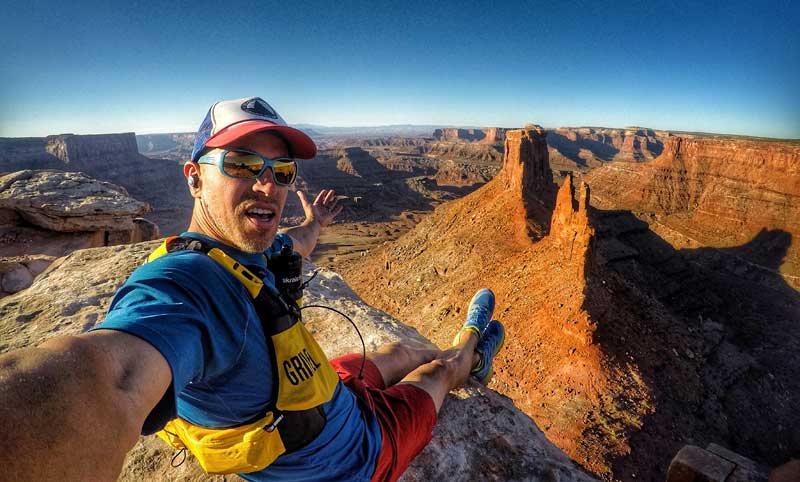
TCM: NuCamp definitely has an eye for modern interior design. You are the first person we have interviewed with a Cirrus 920 . What led you to that specific camper?
Aaron: I live in Cody, Wyoming, which is a gateway to Yellowstone. We had been looking at used campers, and couldn’t find anything that didn’t look like it was built in the 1980s. For the money, I couldn’t justify a camper that we weren’t in love with.
A year into looking, I saw a Cirrus truck camper drive through town. From the outside it looked cool and had a different look to it. I looked Cirrus up on the internet and it was what we were looking for.
At the time the only model they manufactured was the 820. We had already bought a long bed Ford F350 for a camper. I emailed nuCamp and asked if they had a long bed version. They told me it was going to be out in eight months.
When nuCamp had the 920 ready for production, they got me in contact with Holiday RV in Poncha Springs, Colorado. I picked up my Cirrus 920 in October.
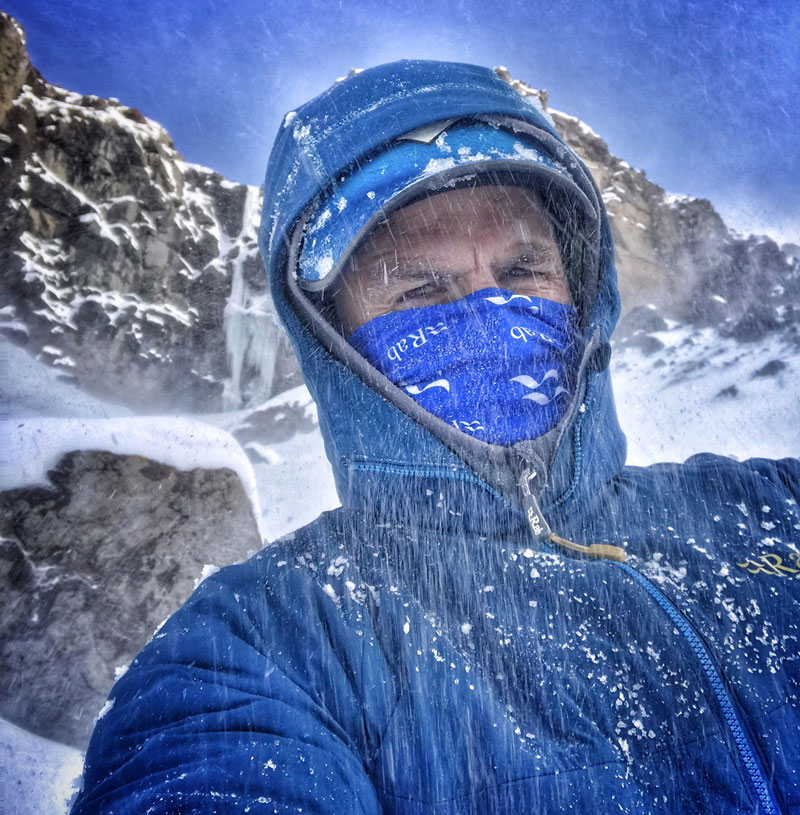
TCM: I’d say that makes you an early adopter. Looking at your photography, you have obviously camped in cold weather. What do you think of the Alde hydronic heating system in the Cirrus?
Aaron: This past winter, the Alde system definitely exceeded my expectations. I’ve been in temperatures multiple days in a row at -9 or -10 degrees. The Alde system kept me warm and comfortable. Obviously I was going through a lot of propane but, on two 20-pound propane tanks, I was able to go for six day trips in extreme cold weather. Also, we were not hooked to shore power.
The way the Alde system works is unique. The Alde heating convectors run behind walls, behind cabinets, and behind cabover bed. There are no warm or cool spots. It’s literally warm throughout the entire camper.
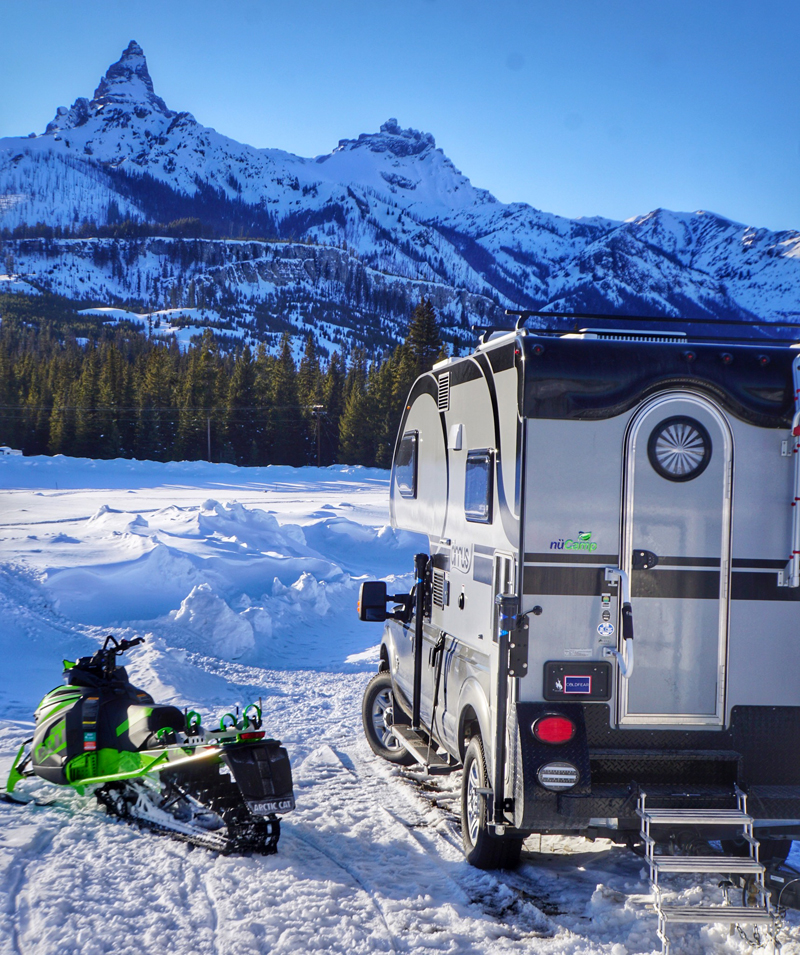
Typical places where a camper would freeze up in extreme cold are warm with the Alde system in a Cirrus. There is a heated tube running through the water pump and tank areas. It’s almost impossible to freeze this camper.
Best of all, the Alde system is quiet. You don’t even know when it’s on. I was a little nervous about it even working when I didn’t hear anything.
With the Alde system, we left our camper heated through the entire winter in a heated storage unit. The Alde was set at 40-degrees. Since I camp throughout the winter, I didn’t want to winterize every time I got back from a trip.
People want to turn on the heat in a camper and feel it instantly. That’s not how the Alde system works. It’s slow to heat but, once it’s heated, the entire camper stays warm. It’s a really impressive system for winter camping.
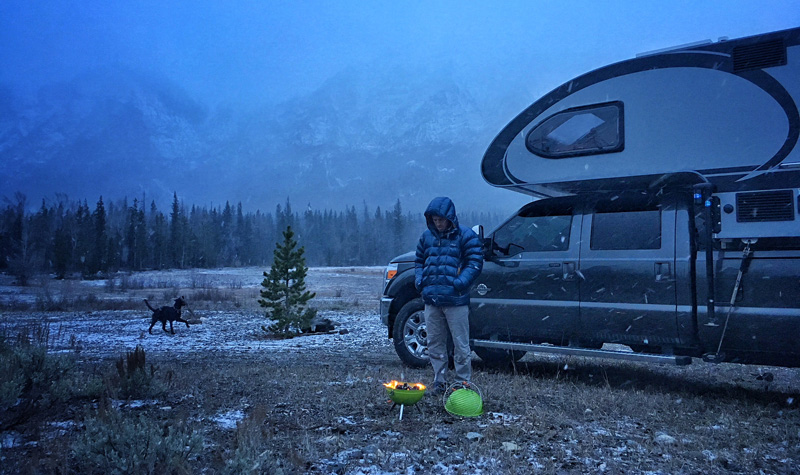
TCM: One of the main drawbacks of a typical RV furnace is the power draw from the furnace fan. Since you were camping off-grid in the cold, how did your batteries hold up with the Alde system running?
Aaron: I have two 6-volt AGM batteries, a diesel generator, and two 100-watt solar panels on the roof. On my six day trips, I kept the heat at 70 degrees. At night the camper was at 65 degrees. Outside it was -9 or -10.
Two hundred watts of solar power was enough to power the Alde system. I didn’t run the generator at all. The batteries would only go down to 70-80% overnight, but the solar system would charge them up in the morning.
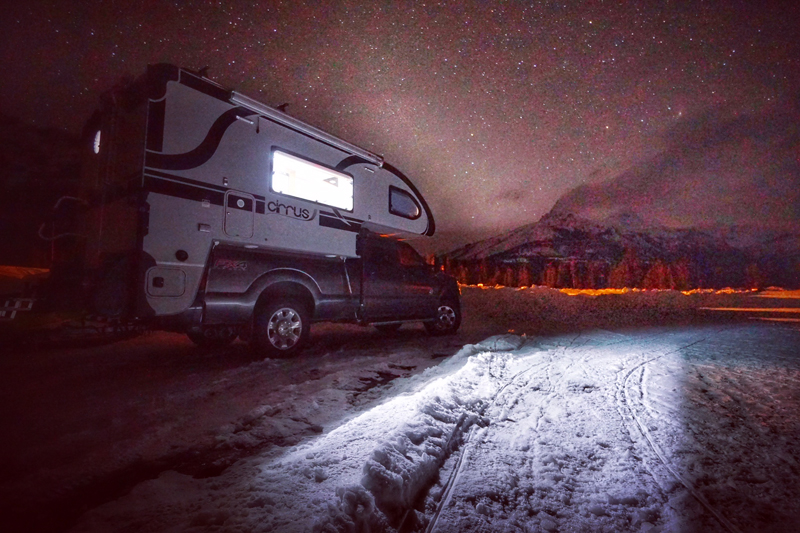
TCM: That’s extremely impressive. I would not even try to camp in our camper in temperatures that low. How did you get into ice climbing?
Aaron: I grew up in California. I moved to Colorado in 1995 when I went to college in Boulder. A friend took me out rock climbing, which was cool. When winter came, he suggested that we go ice climbing.
Then I joined my family for a Thanksgiving in Cody as part of a hunting trip. I wound up ice climbing in Cody on my 21st birthday. I was pretty much in love with ice climbing at that point.
Two years later I moved to Cody for the purpose of ice climbing. I was working for a medical company in Colorado and had an area sales position. In my early twenties, it was probably not the best decision for my dating life.
I was really focused on climbing at that point. It was what I wanted to do. Twenty years later, I am still living here.
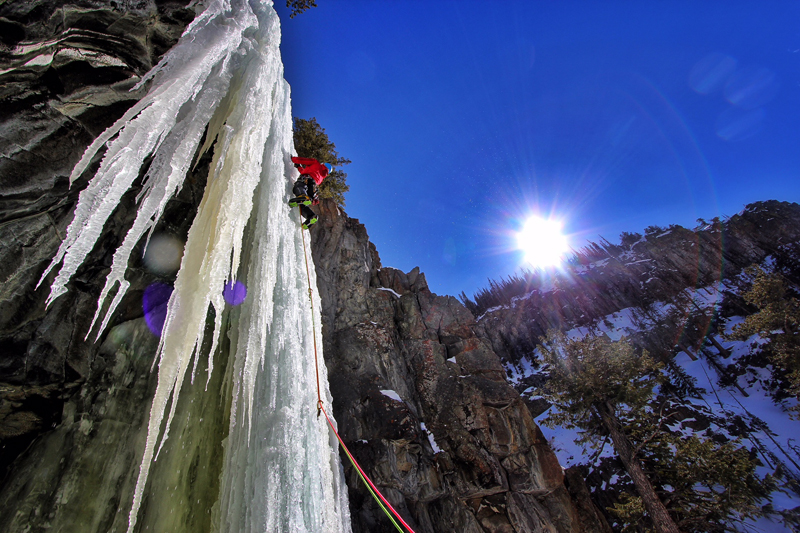
TCM: How does someone learn to ice climb? It sounds like a very dangerous activity for beginners.
Aaron: It’s just as easy as rock climbing. You have to be physically fit. As a beginner there are ice festivals where you can take a class. I travel to those throughout the winter to teach ice climbing and do presentations.
To ice climb at the level where I am, and then push what’s possible, training is a major part of my daily routine. It’s not just to climb the ice, but to understand the movement of it. There is a lot of mixed rock and ice climbing involved. There might be 100 feet of rock to a hanging dagger of ice. To get to where they touch, I am climbing rock. If you look at Cold Fear on Instagram, you will see pictures of me climbing rock and ice.
It makes the climbing harder to connect to the ice drips that are not touching. There are times when I have to hang upside down for 20 to 30 minutes. That’s why I train to push the sport.
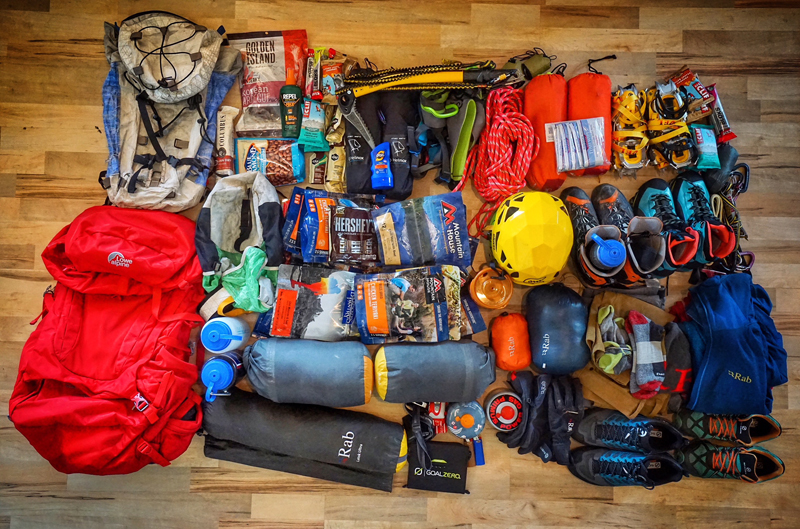
Above: Aaron’s ice climbing pack
In Cody, you need to hike up 1,000 to 2,000 feet in altitude before you get to a climbing opportunity. It’s not a 10 minute walk from your camper. You need to be fit just to make the two to three hour hike to get to the climb. Then, you have to feel 100-percent and have the strength for the climb. Training to get to the next level has been the game changer.
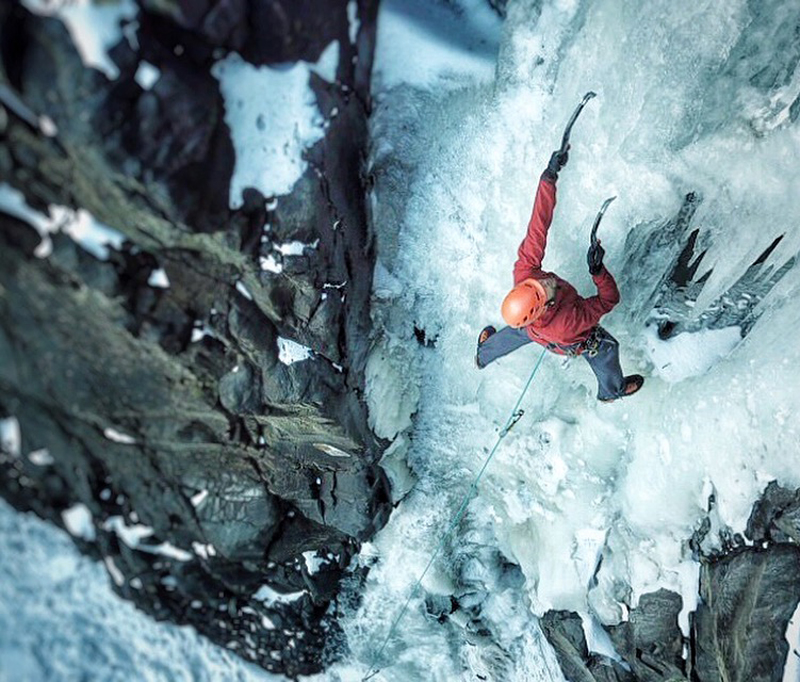
TCM: 20 to 30 minutes upside down? That’s insane. How does someone even climb on ice?
Aaron: To climb a frozen waterfall you need ice climbing tools. First, you need an axe in each hand. Then, you have a crampons on your feet that have sharp points toward the bottom. You kick the crampons into the ice.
To climb, you swing each of those tools to put placements into ice. The tools slice the ice to create a good hold. Over time you gain comfort with the ice.
Ice changes in form quite a bit. Temperatures are dependent upon the conditions. With colder brittle ice, more ice comes off when you swing and kick.
The prime temperature is 30 degrees for climbing. The ice is supple, moist, and is not quite as rigid. I’ve climbed when it’s 50 degrees and the ice is like styrofoam.
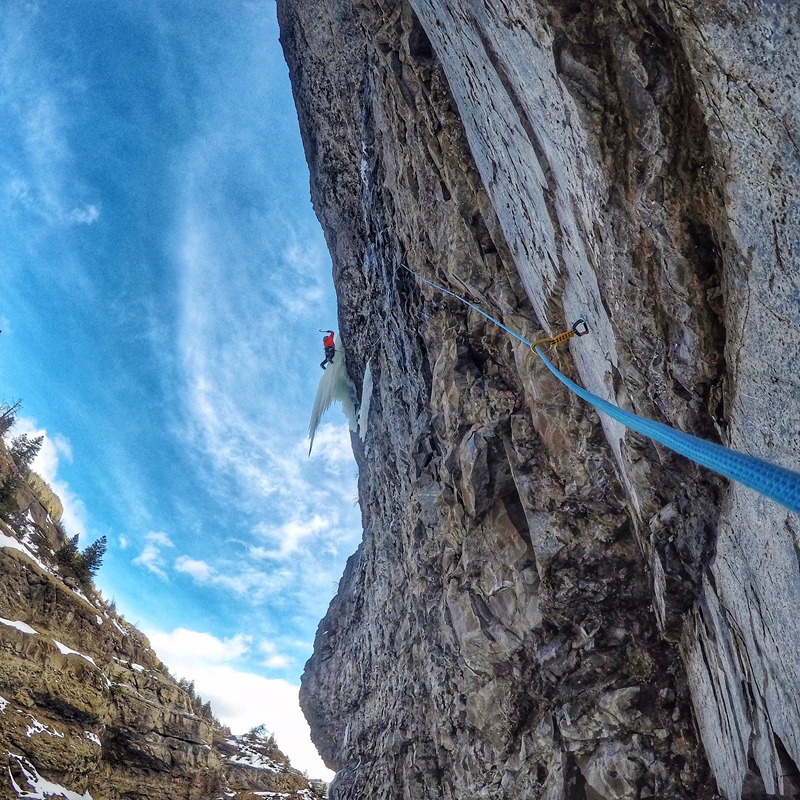
TCM: What do you do to prevent yourself from falling? Are you completely dependent on the axes and crampons?
Aaron: We use ice screws and a rope for safety. Imagine a wood screw, but bigger and hollow. Ice screws are a 1/2-inch in width. When you put an ice screw into the ice, out comes a core. Then you clip to the ice screw and that becomes your protection.
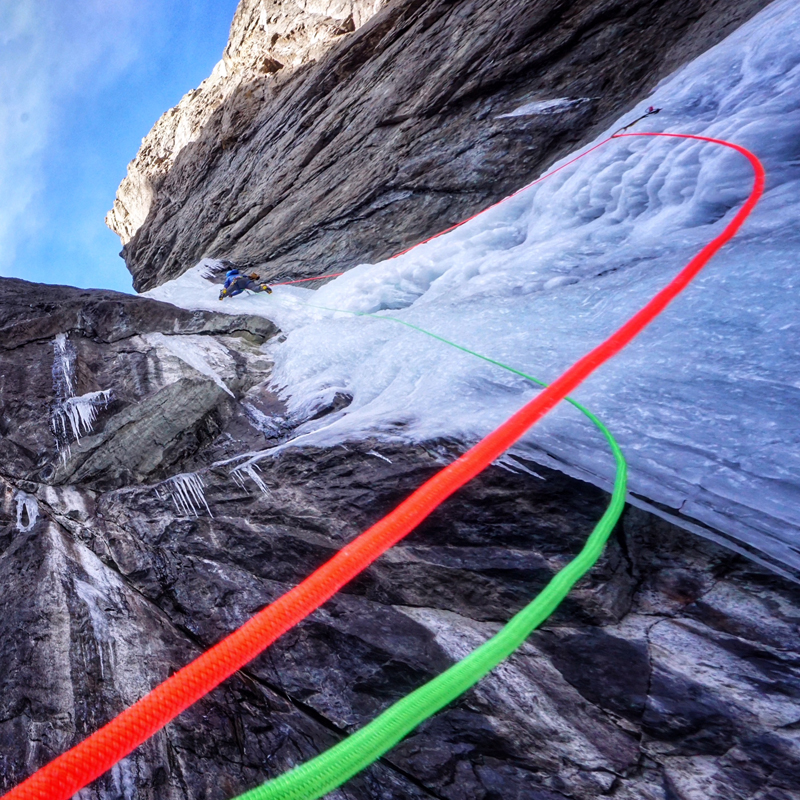
TCM: And these ice screws are strong enough to prevent a fall?
Aaron: Yes. Ice screws that are done correctly are incredibly strong in good ice. The common rule is don’t fall.
TCM: How many ice screws do you put in during a typical climb?
Aaron: I don’t carry more than 12 screws with me, and the rope is 220 feet. With the rope and ice screws you can only fall as far as one notch down. If I am 100 feet up and the screw is 20 feet down, it’s a pretty big fall, so there could be an injury.
The distance between ice screws is dependent on how comfortable you are climbing. I go 20 to 30 feet without screws. If something is overhanging or more difficult, I put in more screws as I go up.
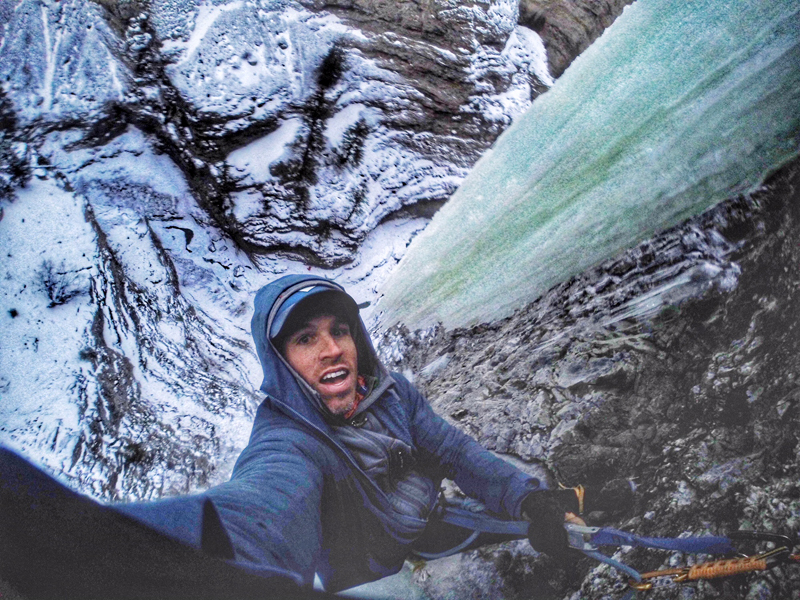
TCM: Have you ever fallen during a climb?
Aaron: I fell and an ice axe cut into my bicep on the way down. I was five hours into climbing. I sucked it up and stayed there for a couple days since we had just gotten all the way there.
It felt like I had been shot. I had to get a tetanus shot when I got back.
I have had some close calls with icicles falling. Pillars have also fractured when I’ve been on them. One shifted when I was on it. I was by myself with no rope. I had to figure out to be calm. If I fell it was a long way to ground. That wouldn’t have been a good scenario.
Once I topped out and pushed from the column, the entire column fell. That was a close call. I sat on top and beat myself up. It was a stupid decision. That gained me a better understanding and respect for the ice. You have to know when you are willing to bet your chances and when not to. It’s a gamble at times, but now I gamble less.
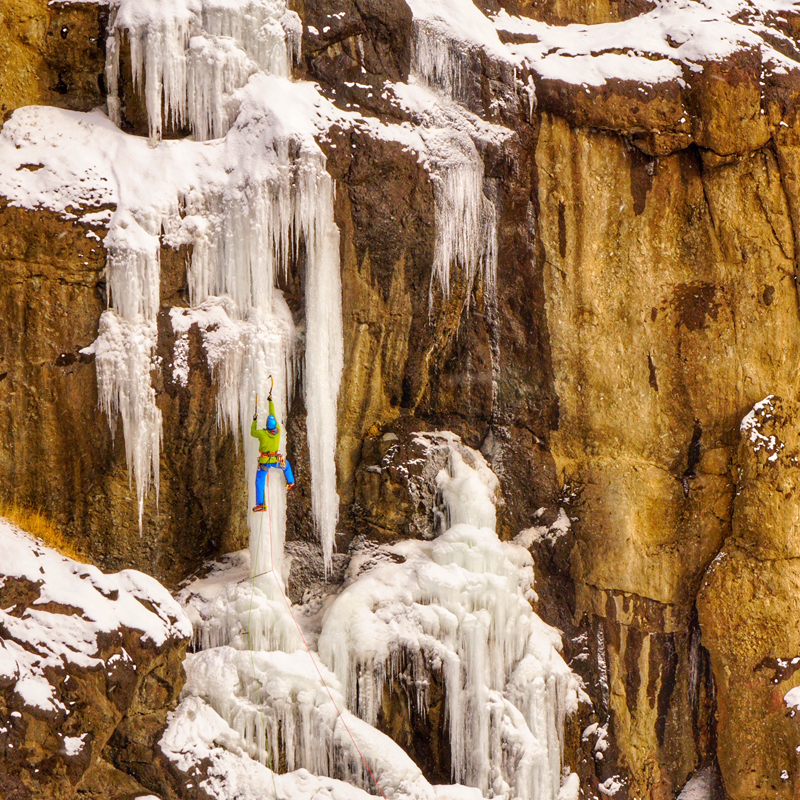
The scariest climbing is on the skinny pillars. You have to have a good feeling. The big giant ice flows are stable because of their surface area. Ice is really strong. Think about ice on a pathway or street, and how difficult it is to kick off with your feet. It adheres well. Ice adheres very well to walls and giant surface areas.
I still find myself making mistakes, but I get smarter as I get older. The more you ice climb, the more you understand your abilities. I am careful, and I have learned to understand the ice.
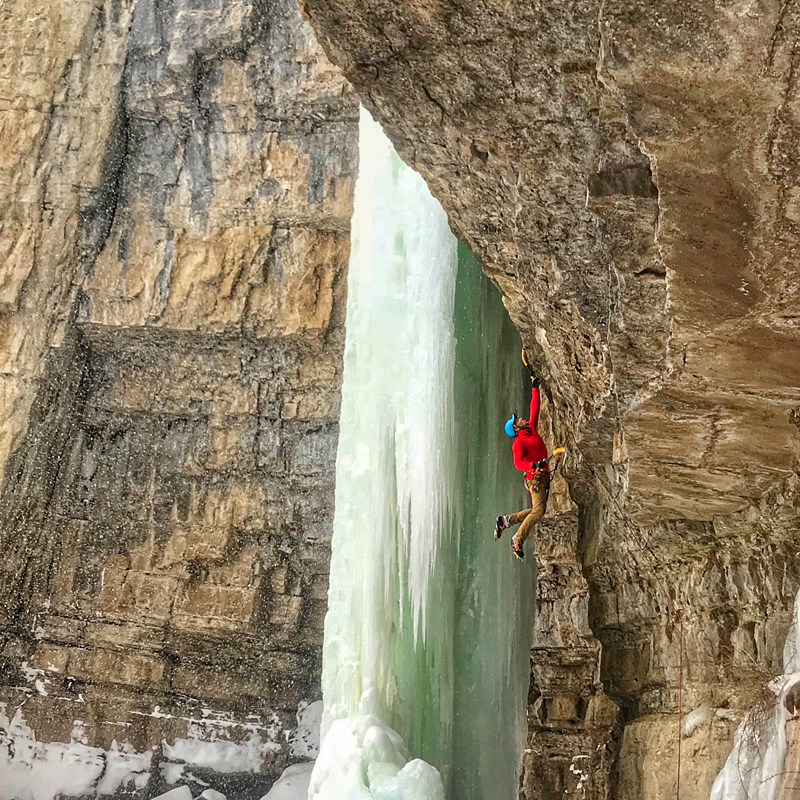
TCM: You said you’re pushing yourself and the sport. What does that mean exactly?
Aaron: I now look for the difficulty of the climb and balance that difficulty against the chances of falling. I walked away from a pillar a month ago that I’ve been chasing for fifteen years. The way it connected, it looked weird and unstable in the way it had formed. It knew in my gut that it had a weak point. I sat there for 45 minutes studying it.
As I was about to hike up on the cliff, my friend told me to come up higher. The point where it was the weakest I could see a fracture line. That was exactly where I thought weak point was. I have to listen to myself and my experience. Ultimately I walked away, which was not easy.
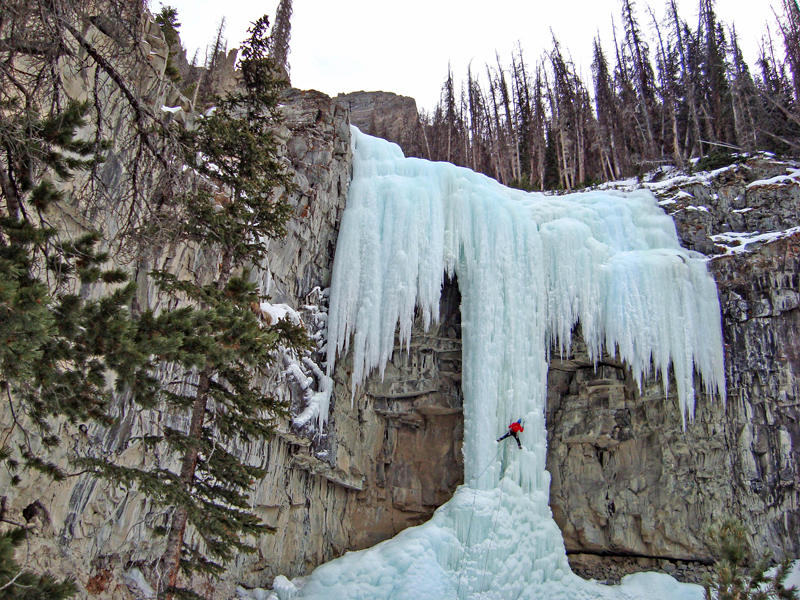
TCM: How do you get down after a successful ice climb?
Aaron: If you’re lucky, there’s a tree to wrap the rope. If you don’t have a tree, we do what’s called a V-thread.
If you can imagine, the ice screw is about 8-inches long and there is a flat surface of ice. When you insert the ice screw it goes in at an angle. You take it out and put the same screw in angling towards the hole you just made. It makes a hole in the ice that connects. You are creating a tunnel in the ice with the screws.
Then you feed the rope through and repel off the ice. People freak out because you are repelling off four to five inches of ice, but you have to think about the surface area. We do V-thread descents all the time.
As the leader, you go up and put the ice screws in. When you get to the top, your climbing partner climbs up. He or she takes the screws out as he/she climbs. The ice screws are $80 each, so we do not want to leave them in the ice.
TCM: Other than Cody, where do you go to ice climb?
Aaron: I am most well known for the fact that I’ve done about 200 first descents in the United States and Norway. First descents are climbs that nobody has ever climbed. I want to find ice that has never been climbed before. That’s my goal and that’s what most of my sponsors have sponsored me for. It’s fun to discovering new ice.
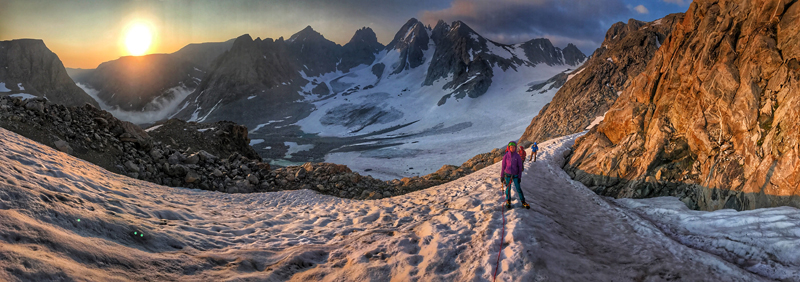
TCM: How do you find ice that no one has climbed before?
Aaron: I have to hike and find them. Sometimes it winds up just being a hike. Typically I am going to a place to find new things. I have slept on a mountain curled up on a pad. With the Cirrus, I am able to go back to the camper and then go out again.
TCM: Do you make a living ice climbing?
Aaron: Most people in the climbing world consider me a professional climber. I am a sponsored athlete and I make presentations around the country.
That said, ice climbing is not something that I can retire on. I am not making the money of a football player. Ice climbing and rock climbing are boring to watch. For the public, it’s not an attractive sport.
I work full-time for a medical company as a Regional VP of Operations and Sales. I manage 250 people. I oversee most of the western United States. As long as I have a computer and a phone I can work from anywhere. I work long days. Then, I make sure that my free time is used wisely. I stockpile those days.
Ice climbing is what makes me good at my job. I have that break from work. When I’m out, I’m not thinking about work. It is a stress relief and gives my mind a reset. I am addicted to the feeling of being on the edge. When summertime comes around, or I haven’t climbed for a couple weeks, my wife says that I need to be outside because I get irritable. Ice climbing is refreshing for me.
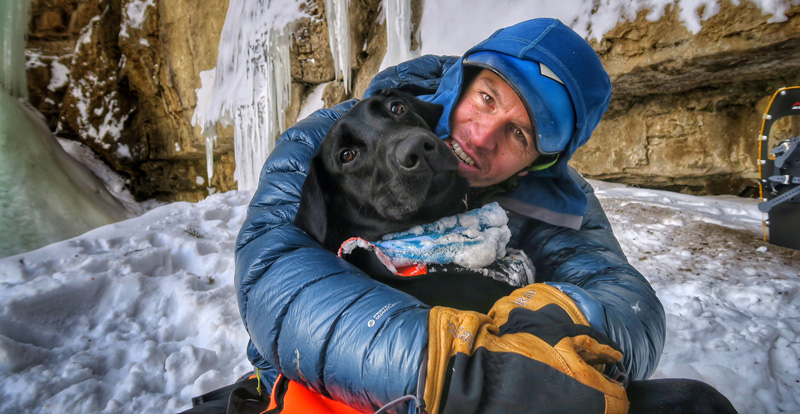
TCM: What is Coldfear?
Aaron: I started Coldfear.com as a blog back in late 1990s/early 2000s. It was a website for ice conditions in Cody. South Fork Valley in Cody is one of the best places in the world for ice climbing. People will travel a long way, so they get on Coldfear.com to check the conditions.
From that people started to know me as Coldfear. It’s a brand for myself. Now I sell Coldfear T-shirts. A lot of that money goes for bolts and anchors so that other people can do these routes safely. That website funds my climbing efforts.
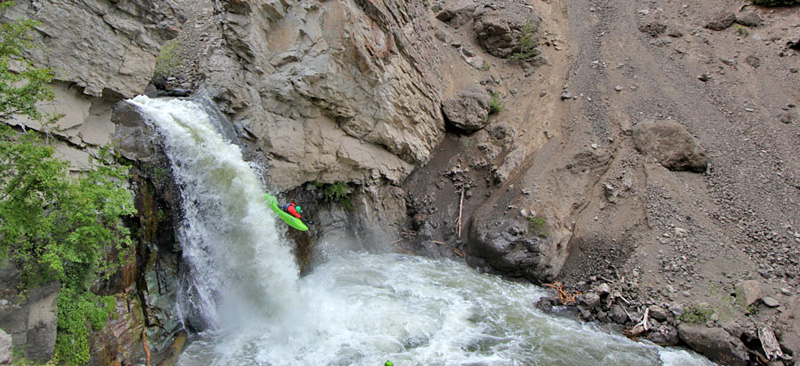
In the summer I trade my ice tools for kayaking. That’s my second passion. I have done the same types of things with kayaking. Kayaking rivers and waterfalls has become a passion. I have had a handful of first descents on waterfalls and creeks that have never been run before.
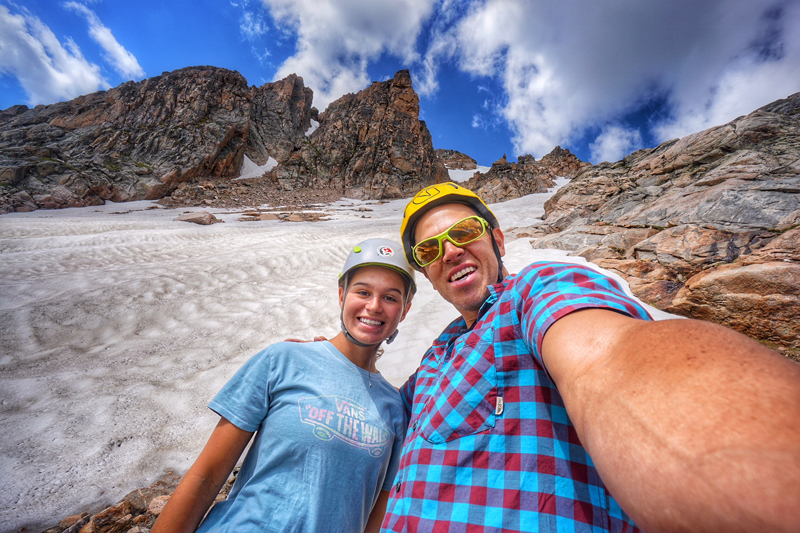
Above: Aaron and his daughter go ice climbing together
TCM: Do your friends and family worry about your on-the-edge lifestyle?
Aaron: My mom and dad have grown to know what it is. They know if I didn’t do it, I would not be as happy and motivated. They understand that.
My wife has only known me as an ice climber. She actually won me at an ice festival. They auctioned off a day of climbing with me and she won. She has climbed with me, but she doesn’t want to do the level of climbing that I do. She wants to just have fun days climbing. She also knows it’s what makes me tick.
My son is 17 and my daughter is 15. I was set on not pushing my activities onto my children. My son doesn’t have the passion to do it and is interested in other things. My daughter really likes climbing, so you’ll see pictures of her and I climbing.
We have climbed big peaks together and we have ice climbed together. We went to Granite Peak last summer and we were out over five days. For her, that was a big deal because it was hiking 25 miles one way.
On the summit day we started early before the storms come in. She started puking at 4:00am, and then she said, “I feel better now”. She gets nervous. She didn’t really smile until the top, but then she did. I was proud of her. She is 15 years old and pressed through her fears. That was impressive.
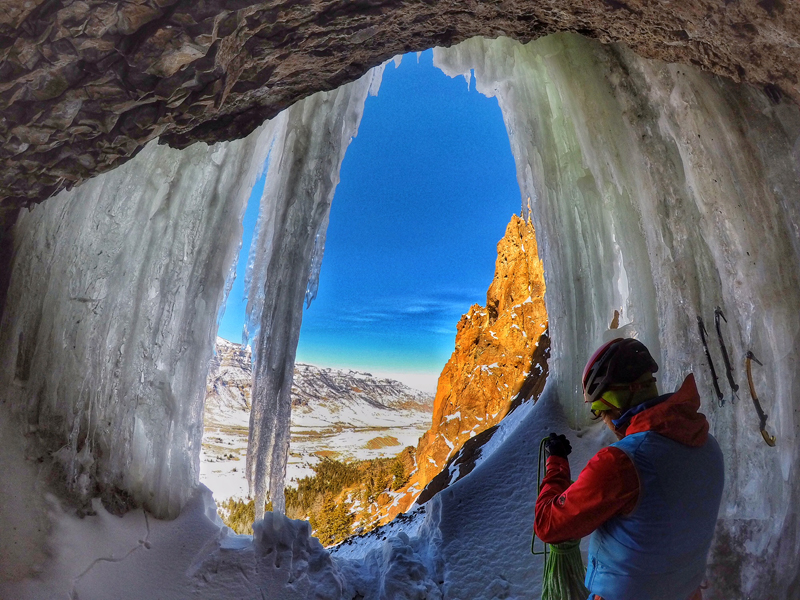
TCM: How do you get your amazing climbing photos?
Aaron: My photos and videos are a combination of others taking them and me taking them. I love taking photos and videos. I wish I had more time because I have stockpiles of photos and videos that may never surface because I don’t have time.
I took most of the stuff I post online. I use a GoPro, a DJI Mavic drone, and a Sony a6000. The Sony is heavy to carry, but it’s worth it.
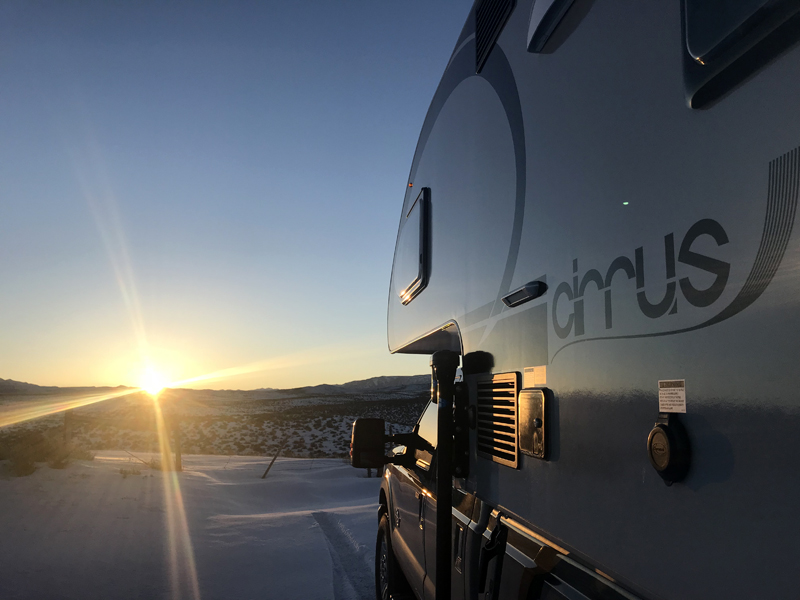
TCM: How does your truck camper come into play with your ice climbing?
Aaron: It’s a lot less driving having the camper. It’s more comfortable. As I get older, sleeping in the back of a car is less appealing. A good night’s sleep means that I’m super motivated and warm.
The truck camper allows me to get to places that would have otherwise meant packing and camping in a tent overnight. Now I don’t have to do that. I just hike a couple miles to get to the camper.
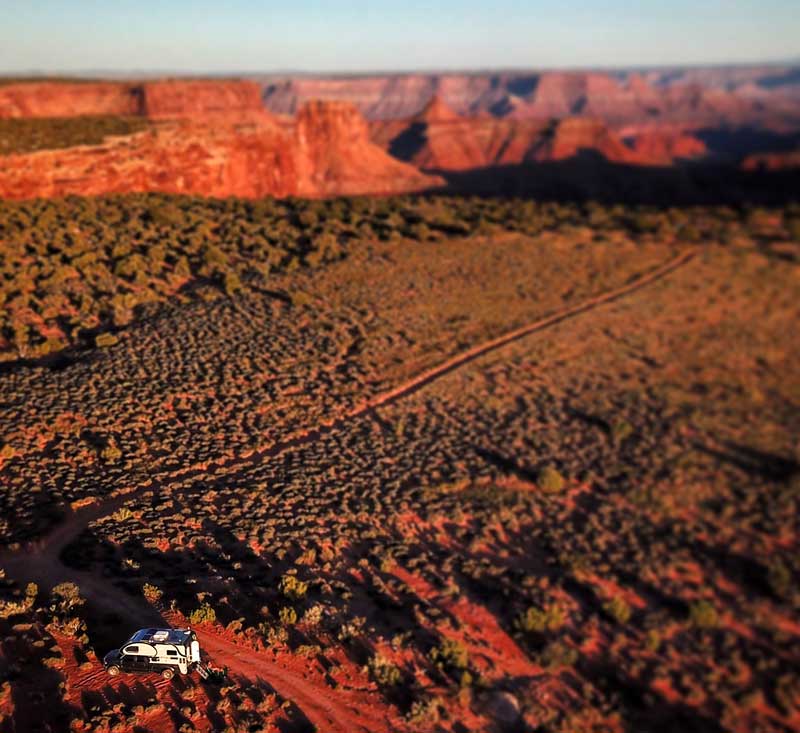
I also can be out on the road longer and stay back in more remote places. I do not have drive to a hotel. The truck camper changes the game for me in that realm. I don’t have to go back and forth, and no tent.
Now that we have the camper my wife comes along for more outings than she normally would. I’ll be out climbing and she’ll go skiing, snowshoeing, or walk around. She can be with me and not in the car waiting for me.
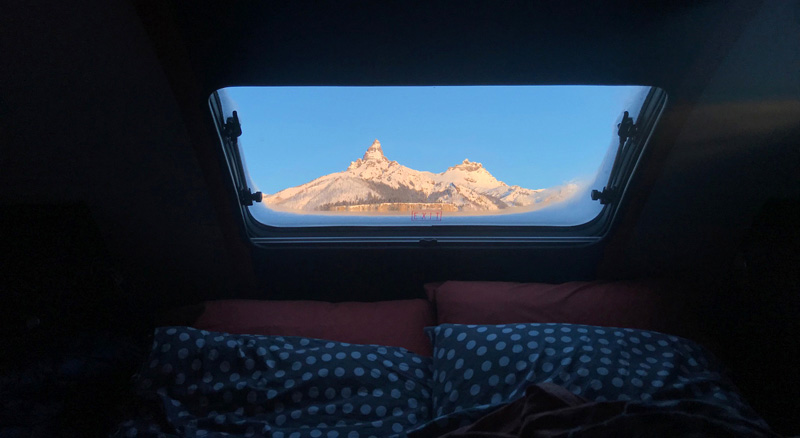
TCM: You also have a beautifully shot film called The Pursuit (featured at the top of this article). Tell us about that.
Aaron: It’s a film I made that’s a combination of footage over a couple years. A buddy of mine, Chris Alstrin, had a hard drive of video footage. 80-percent is mine, and 20-percent is what he shot.
In the climbing world there are long hikes and suffering. The Pursuit showcases the climb and motivates people to go beyond the end of the trail. Maybe they will go around one more corner. I want them to have the life perspective of stepping out of their comfort zone.
TCM: I know we did just watching the trailer. What’s next for you?
Aaron: I am training to go to Peru in August to run a Ultra Run, which is 28 miles across the Cordillera Blanca Range. In a couple weeks I will be traveling to the desert to do big training runs. The race in Peru is at 12,000 to 16,000 feet. I will have twelve hours to complete 28 miles. That’s what I’m training for. I will be in the camper to train and work. I’m looking forward to more time camping.
Aaron Mulkey’s Rig
Truck: 2017 Ford F350, crew cab, 4×4, diesel
Camper: 2018 Cirrus 920
Tie-Downs and Turnbuckles: Torklift Fastguns
Suspension: None
